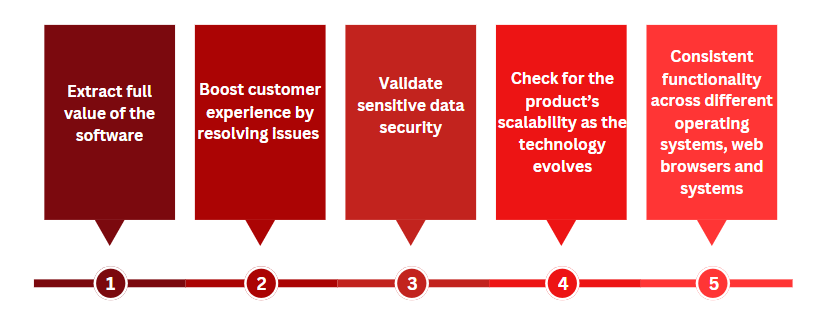Software as a service (SaaS) is an ever-evolving industry that leverages technological advancement to become more powerful and sophisticated. With industry industry giants of the likes of Netflix, HubSpot, Salesforce, Zoom, Google and Dropbox, all based on SaaS model, the ease of its implementation, simplicity in updating and debugging and less expensive than its counterparts makes SaaS applications a preferred choice of software licensing models.
In fact, a Gartner report estimates that by the end of 2023, the SaaS landscape might reach a potential value of $195.2 billion and is projected to reach $908.21 billion by 2030. With the pace this industry is expanding, by the next two years, almost 85% of all business products will be SaaS applications and almost half of world’s data would be stored on cloud.
While these projections are likely to go up in the consecutive years, the need for SaaS based application testing, leveraging the right approach and tools cannot be understated.
What is SaaS Testing?
SaaS based application testing is the methodology for testing SaaS product quality through a series of required activities.
As the SaaS application market is undergoing a paradigm shift, this transformation is a direct result of changing customer preference, market competitiveness, technology advancements and the changing economic and regulatory conditions. These changes demand a high-quality SaaS product which is tested for bugs, scalability, quality and efficiency before it is released in the market, hence the need for reliable testing to:

SaaS Based Application Testing Challenges
While no two SaaS applications are the same, they do pose substantial challenges during the testing process. Some of the common SaaS based application testing challenges include:
- Process Development: Maintaining a uniform process that helps obtain short development cycles, maintain consistent quality standards and lead to product enhancements can be challenging when SaaS platforms are tested, owing to the complexity of these systems.
- Security Issues: Considering the short release cycle and frequent adjustments in SaaS based application testing, data can be left unprotected, unless the security protocols are identified right at the start of the development cycle.
- Third-Party Integrations: SaaS applications rely on third-party software to perform their roles. This raises the need for identifying and designing thorough API testing which checks for both inbound and outbound data to review the functionality of third party software as well.
- Test Coverage: With the expansion in SaaS platforms, these applications are now extensively used by people across the globe. This creates the need for ensuring its quality and performance in different environments with different configurations.
- Selecting Appropriate SaaS based applications testing tools: While there are a myriad of testing tools at your disposal, leveraging the ideal tools suited for your work requirements, application and budget makes all the difference.
Best Approach to SaaS Based Application Testing
The best approach to SaaS-based application testing involves a structured and comprehensive process that encompasses several critical stages:
I. Planning
This initial phase sets the foundation for the testing process. It begins with a thorough requirement analysis, which involves understanding the specific functionalities and features of the SaaS application that need to be tested. Test environment setup is crucial, as it ensures that the testing environment mirrors the real-world usage scenario. Test case design is another essential aspect, as it defines the scenarios and conditions under which the application will be tested. Additionally, data preparation involves generating and organizing the test data that will be used during the testing process.
II. Execution
This phase is where the actual testing takes place. It involves various types of testing, including:
- Functional Testing: This ensures that the application’s features and functions perform as expected.
- Performance Testing: This assesses the application’s speed, responsiveness, and scalability under different loads and conditions.
- Security Testing: This examines the application for vulnerabilities and potential security risks.
- Usability Testing: This focuses on the user experience, assessing how user-friendly and intuitive the application is.
- Regression Testing: This ensures that new updates or changes haven’t introduced new issues or negatively impacted existing functionalities.
III. Analysis
Once testing is completed, the analysis phase begins. This involves evaluating the test results to determine whether the application meets the specified requirements and quality standards. Root cause analysis is crucial in identifying the underlying reasons for any defects or issues uncovered during testing. Prioritization is essential for categorizing and addressing issues based on their severity and impact on the application. Re-testing ensures that any identified issues have been successfully resolved and verifies that the application now functions as intended.
Developing an effective SaaS based application testing application, network and infrastructure need to be considered as its three core elements where:
- Application incorporates testing the application that is concerned with the business workflows, data integrity, responsiveness, end-to-end integrations, non-functional requirements like performance & scalability or access roles.
- Network includes examining the network components and ensuring they are managed by cloud service providers. It guarantees secure data transfer between SaaS applications and the customer network and ensures that the infrastructure associated with the network can handle application bandwidth demands without compromising its performance.
- Infrastructure element ensures that the platform subscribers can access SaaS applications without any disruption. It also verified that the infrastructure is designed with robust disaster recovery readiness, complies with the regulatory as well as legal standards and can be backed up during any disruption.
While implementing SaaS based application testing automation in platforms, it is crucial to not overlook:
- Data Driven Approach: This approach offers several advantages, including increased reusability, enabling the same scripts to be used with different data inputs and reducing script redundancy. It also facilitates comprehensive testing by accommodating a wide range of scenarios, effectively uncovering potential issues related to data handling. Moreover, it enhances testing efficiency as automated tests can cover multiple test cases using a consistent script structure.
- Record and Play Approach: This approach of recording manual test actions and their subsequent conversion into automated scripts is particularly valuable for testers who may lack programming skills but possess a good understanding of the SaaS application’s functionality. It offers benefits such as ease of use,, allowing the rapid initiation of test automation by recording actions during manual testing.
- Keyword-Driven Approach: Tests are constructed using a predefined set of keywords or commands. Testers define the test steps using these keywords, and the testing tool interprets and executes the steps accordingly. This approach facilitates enhanced modularity, which in turn improves script maintainability. It also encourages collaboration among testers, as they can collectively participate in test creation by defining keywords and test steps.
- Hybrid Keyword Approach: This approach empowers testers to create tests using a combination of keywords and test data, offering a perfect balance between flexibility and reusability. It allows for comprehensive testing by utilizing keywords for common actions and integrating data-driven testing for scenarios that demand variations to ensure a wide spectrum of test scenarios are covered. It also offers scalability, enabling test scenarios and datasets to be adapted and expanded as needed.
Tool Selection Criterion for SaaS Based Application Testing
Selecting the right tool for testing software-as-a-service (SaaS) applications is a critical decision for any organization. SaaS-based applications are hosted in the cloud and serve as a fundamental component of modern business operations. To ensure the reliability, functionality, and security of SaaS applications, it’s essential to choose the most suitable testing tools.
Here are some key criteria to consider when evaluating SaaS based application testing tools:
a.Usability
Usability is a fundamental criterion when selecting a testing tool for SaaS applications. The tool should be user-friendly and accessible to all team members, including testers, developers, and other stakeholders. Consider the following factors:
- User Interface (UI): The tool should have an intuitive and easy-to-navigate user interface. Testers should be able to perform tasks without significant training.
- Collaboration Features: Collaboration is vital for efficient testing. Ensure that the tool offers features like shared test cases, real-time collaboration, and notifications to keep the team aligned.
- Accessibility: The tool should be accessible from various devices and browsers to accommodate remote and distributed teams.
b.Collaboration
SaaS applications are often developed and maintained by teams dispersed across different locations. Effective collaboration features within the testing tool are essential for achieving seamless teamwork:
- Real-Time Collaboration: The tool should enable real-time collaboration, allowing team members to work together simultaneously, review test results, and discuss issues.
- Permissions and Roles: Define user roles and access permissions to ensure that team members have the right level of access and responsibilities within the tool.
- Integration with Communication Tools: Integration with popular communication and collaboration tools like Slack, Microsoft Teams, or email can further enhance collaboration.
c.Software Integrations
SaaS applications typically interact with a variety of other software systems. Your testing tool should be capable of integrating with the necessary software, ensuring comprehensive test coverage and smooth data exchange:
- API Integration: Integration with application programming interfaces (APIs) is crucial to test data flow and interaction between the SaaS application and other systems.
- CI/CD Pipeline Integration: If your organization uses continuous integration/continuous deployment (CI/CD) pipelines, the testing tool should seamlessly fit into the pipeline for automated testing.
- Third-Party Integrations: The tool should support integration with third-party testing tools, bug tracking systems, and other relevant software.
d.Issue Tracking
Effective issue tracking is essential for identifying, prioritizing, and resolving defects and issues within the SaaS application:
- Defect Management: The tool should have a robust issue tracking system to log, monitor, and manage defects, including features for assigning, prioritizing, and resolving issues.
- Traceability: It should allow for traceability of issues back to specific test cases, making it easier to understand the impact of defects on the application.
- Customization: A flexible issue tracking system that can be customized to your organization’s specific workflow is beneficial.
e.Pricing
The cost of a testing tool is a crucial consideration for any organization. When evaluating the pricing of SaaS-based application testing tools, keep the following in mind:
- Scalability: Consider how pricing scales as your testing needs grow. Ensure that the tool’s pricing structure aligns with your organization’s growth.
- Free Trials: Many testing tools offer free trials. Take advantage of these trials to evaluate whether the tool meets your requirements.
- Total Cost of Ownership (TCO): Assess not only the initial subscription cost but also any hidden or ongoing costs, such as training, support, and additional features.
What’s Next in SaaS Based Application Testing?
The world of software-as-a-service (SaaS) is in a constant state of evolution, and so is SaaS based application testing. Staying ahead of the curve and ensuring the quality and dependability of SaaS applications necessitates a forward-looking perspective. This entails embracing the incorporation of Artificial Intelligence (AI) and Machine Learning (ML) in testing to recognize patterns, anticipate issues, and automate test case generation. It also involves accommodating the increasing complexity of SaaS applications with scalable test automation, replicating real-world scenarios in performance testing, adopting a shift-left testing approach for early issue detection, addressing security concerns through comprehensive testing, and implementing continuous testing in line with continuous integration and delivery (CI/CD) practices.
Organizations must embrace these trends and harness cutting-edge tools and technologies to ensure that SaaS applications remain reliable and meet the ever-changing expectations of users.


